Signia TeleCare – the Future of Hearing Care Starts Now
György Várallyay, Ph.D., and Rebecca Herbig, Au.D.
Introduction
Do you remember your first mobile phone? It was big and heavy, and it took minutes to write a short text with the twelve buttons. Reading the messages on the tiny monochrome display was equally challenging. Later, we could actually send very low resolution photos to each other. What an improvement!
Thankfully, mobile technology has developed so much so that today, we are using our smartphones easily for many things. We can send huge files to each other, surf the internet, keep in touch with friends and relatives, share our favorite moments via social media, or even watch “how-to” videos on YouTube.
What would you say if smartphones can even help you provide hearing care? What if there is a smartphone application which could ensure a continuous and secure communication channel between the hearing care professional (HCP) and the patient? What if during the critical hearing aid trial period, there is an app which provides continuous support to help the patient’s adjustment to the new devices? What if the HCP can easily send new settings remotely to the patient’s hearing aids as needed without the patient coming into the office? There is no need to wait any longer: Signia TeleCare has just arrived.
Why TeleCare
The most challenging period of adjusting to new hearing aids is typically the first few weeks. The patient has to get used to the new amplified sound in a wide variety of acoustic situations, which pose many challenges and bring forth questions for both new and experienced users. Wearer expectations are not necessarily realistic, as patients may not know how hearing aids should sound, or what is best for them the long term. For example, even if high frequency amplification is necessary for maximizing speech understanding, these amplified sounds might be disturbing for the patient in the first weeks because he has not heard them in years, or even decades. As a result, roughly one out of every four patients return to the follow-up appointment having decided to return their hearing aids (McCormack & Fortnum, 2013).
MarkeTrak VIII reports that the most common reasons for hearing aid returns are overall low benefit and performance in background noise (Kochkin, et al., 2010). These problems typically can be managed and resolved easily with appropriate counselling and fine-tuning. But unfortunately, most of these problem first
surface outside of the HCP’s office during the first weeks of hearing aid home trial between the initial and follow-up fitting appointments. For example, the patient may find a certain listening situation too loud, but he has forgotten that it is possible to turn down the hearing aid volume, or switch to a different program. Or a patient finds that his hearing aids are not helping him hear better simply because he has neglected to change batteries and the hearing aids are no longer working.
These are “moments of truth” during the trial period that determine whether a patient decides to ultimately keep his hearing aids or give up on amplification (Figure 1). Yet during this most critical time period, he is for the most part on his own without continued professional guidance and support. This problem is exacerbated if there is a bigger geographical distance between the patient and the HCP, or if the HCP is too busy to address patient phone calls or emails in a timely manner. As a result, unsolved problems and unanswered questions often lead to frustration and discouragement, so that by the end the trial period, the patient has already decided that hearing aids are “not worth the trouble.”
Up to now, there has been a lack of systematic feedback or communication during this most crucial phase of hearing care between the patient and the HCP. An efficient communication pathway could help the HCP closely monitor patient progress and solve problems as they arise, thus ensuring that the trial experience remains positive and patient motivation for amplification remains high.
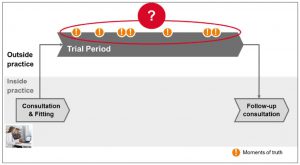 Figure 1. Patient problems and questions which surface during the trial period are “moments of truth” which influences whether the patient will ultimately keep the hearing aids.
Figure 1. Patient problems and questions which surface during the trial period are “moments of truth” which influences whether the patient will ultimately keep the hearing aids.EuroTrak studies have showed that there are three main drivers of patient satisfaction (European Hearing Instrument Manufacturers Association, 2016):
- The HCP: professionalism, consultation, service during the fitting and follow-up, etc.
- The features of the devices: battery life, comfort, discreet design, reliability, etc.
- The perceived product performance: speech understanding in different situations, usage in noise, the richness and clarity of sounds, natural sounds, outdoor activities, watching TV, phone calls, etc.
Beyond choosing appropriate hearing aid technology, there are several ways to help the patient reduce potential problems during the trial period and to increase satisfaction.
- Give the patient easy access to the most important usage related information (e.g. battery change, cleaning).
- Enable the patient to contact the HCP during the trial period to ask for professional guidance and support opinion when questions and problem arise.
- Assign the patient auditory training tasks that promotes adjustment to the new hearing aids (Melody, 2007).
- Monitor performance on training exercises to determine if hearing aid adjustments might be needed.
- Enable the HCP to remotely adjust hearing aid settings during the trial period as needed. This minimizes in-office visits and immediately allows the patient to try out the new settings in real world situations.
In order to manage the critical moments during the trial period effectively and to increase patient satisfaction, Signia TeleCare is a new hearing care tool which makes all of the above mentioned functions possible.
Overview of Signia TeleCare
The two main components of TeleCare are the smartphone myHearing App and the web-based professional portal page. The app is designed to be used by the patient. The HCP can help the patient install and activate it during the time of the initial fitting appointment. Via this app, the patient can access hearing aid usage and maintenance information, videos, perform hearing trainings, communicate with the HCP, indicate his daily satisfaction level, and even receive new hearing aid settings.
The portal page is to be used by the HCP. Here the professional has an overview of all his patients who are using the app. It displays patient satisfaction ratings, provides a well-structured communication channel with the patient, and enables remote fine tuning of the hearing aids.
The myHearing App and the HCP portal page are online services, enabling a close yet secure connection between the patient and HCP. In case of low satisfaction ratings, or poorer-than-expected performance on the hearing training exercises, the TeleCare system alerts the HCP so that she can contact the patient, and finetune hearing aid settings remotely if necessary. This way, the patient benefits from consistent, timely, high quality professional service and remote support throughout the trial period, and those critical “moments of truth” can become positive experiences for the patient (Figure 2).
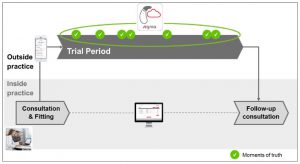 Figure 2. The Signia TeleCare solution brings the patient and the HCP closer to each other during the trial period so that in critical moments, the HCP can effectively support the patient in real-time.
Figure 2. The Signia TeleCare solution brings the patient and the HCP closer to each other during the trial period so that in critical moments, the HCP can effectively support the patient in real-time.Thanks to TeleCare, the patient’s trial period becomes much more transparent for the HCP so there are no surprises when the patient returns to the practice for the follow-up appointment. For the patients, the TeleCare system means continuous, high quality, professional support; they will recognize that they are never entirely alone during the process of adapting to hearing aids.
In the following sections, we discuss the most important components of the TeleCare system, first from the patient’s point of view, then the HCP’s.
TeleCare from the patient’s point of view: myHearing App
The myHearing App accompanies the patients throughout their trial period. It helps the patient to adjust to the hearing aids and provides a continuous connection with the HCP. The application can be downloaded for both iOS and Android devices free of charge. When the HCP sends a message or new hearing aid settings to the patient, the smartphone alerts the patient immediately.
The application has three main sections: My Hearing Success, My Hearing Aid, and My Professional.
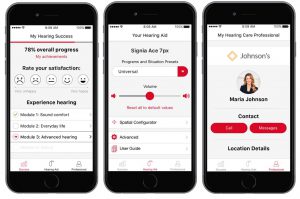 Figure 3. Screenshots from the three pillars of the myHearing App: My Hearing Success, My Hearing Aid, and My Professional.
Figure 3. Screenshots from the three pillars of the myHearing App: My Hearing Success, My Hearing Aid, and My Professional.My Hearing Success
The structured and “gamified” auditory trainings activities can be found under this section. The trainings invite the patient to go into different real-life situations so the patient can try out his hearing aids in several acoustic environments during the first few weeks. “Watching TV”, “In the restaurant” or “Listening to music” are some examples for these tasks. A short description for each situation informs the patient what and how he should hear, helping him to set appropriate expectations for these new listening experiences.
When the patient has finished the listening task, he is asked to rate the sound quality of the hearing aids as a final step of the training. If the patient selects a neutral or negative rating, the application asks the patient what he has not liked, and forwards this information to the HCP. Beyond these training exercises, there are also short informative videos and texts to further educate patient about hearing loss and hearing solutions.
The myHearing App unlocks new and more advanced hearing trainings every week, according to the training plan set by the HCP. As the patient completes these tasks, a progress bar tracks his advancement. In addition, the patient also earns badges (e.g. “Newbie”, “Expert”) along the way. This is another gamified aspect of this app which helps to maintain motivation and foster a more positive trial experience.
Another very important part of the My Hearing Success section is the rating of daily satisfaction. The patient can rate every day how well he likes the performance of the hearing aids during that day. Similar to the hearing trainings, if a neutral or negative daily satisfaction rating was given, the app asks the patient to provide more details about the low rating and forwards this information automatically to the HCP. As a result, the HCP is always notified in a timely manner if the patient is not satisfied with the hearing aids due to any reason.
My Hearing Aids
In this section, the patient can remotely control the instruments, and search for useful information about his hearing aids (e.g. cleaning tips, troubleshooting). Beyond the basic remote control operations (program change, volume adjustment, sound balance), the myHearing App contains the Spatial Configurator feature which can be used to set the directionality of the hearing aids according to individual preferences (Várallyay, Pape, & Meyers, 2015).
One of the key features of TeleCare is that it allows the HCP to remotely send hearing aid setting adjustments directly to the patient. Let’s consider the following scenario. The patient finds that the hearing aids sound too shrill in a certain situation. He texts his HCP to report the incident via the myHearing App. The HCP, in response, initiates a voice call to discuss the patient’s problem. At the conclusion of the conversation, the HCP decides to lower the high frequency gain on the patients’ hearing aids. She can easily make this adjustment directly in the portal. Instantaneously, the patient receives an alert via the App that the HCP has sent new hearing aid settings. As soon as the patient chooses to accept the new settings in the My Hearing Aids section of the app, the settings are immediately implemented in his hearing aids.
This remote fine tuning feature means that the patient can reach out to the HCP when problems arise in certain listening situations, and have it resolved effectively on the spot, without the hassles and time necessary for an office visit. What’s more, the fact that this all is happening in real-time means that the patient has the opportunity to immediately try out the new settings sent by the HCP and confirm if the solution is effective.
My Hearing Care Professional
This section of the app works similarly to other chat apps such as Facebook Messenger or WhatsApp. The most important purpose of this section is the easy communication between the patient and the HCP. The name and a photo of the HCP is displayed here for a more personal touch. The patient can text the HCP in case of any unexpected experience or questions, or simply initiate a call or a video call. As the HCP answers, the received messages can be also found here.
This section also contains the address and opening hours of the practice for the patient’s convenience.
TeleCare from the HCP’s point of view: professional web portal
While myHearing App was designed for the patient, the professional web portal was designed for HCPs by HCPs. Contributions from over 60 HCPs from more than 30 countries have gone into the development and field test process of this portal in order to optimize its functionality and usability. It provides the HCP with all useful details about their patients using the myHearing App. It is recommended to use the portal from a computer. However, since the portal is web-based, it can also be accessed via smartphones and tablets.
Patient List
Immediately after the HCP logs in to the portal, the patient list is shown (Figure 4). Here the HCP can easily and quickly see all patients in the home trial process, their progress with the hearing trainings and satisfaction rates, and who has sent messages or needs support.
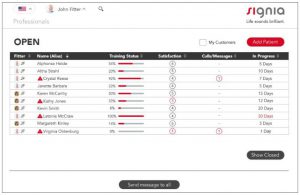 Figure 4. The patient list of the HCP portal page with an informative overview of all patients in the home trial process.
Figure 4. The patient list of the HCP portal page with an informative overview of all patients in the home trial process.
If there are more than one HCP in a practice, it is possible to see an overview of one’s own patients, or all patients from the practice. This is a feature which becomes especially helpful when one HCP takes time off from work and his patients are served by other HCPs in the same practice.
In addition to the patients who are in the trial period, any patient who has been put into the portal can continue to be contacted by the HCP. Therefore, this portal can also serve a convenient tool for HCPs to reach out to all her patient with news, special offers, or even birthdays and seasonal greetings.
It is recommended for the HCP to follow a daily routine when using the portal. For example, open it every morning when arriving at the office, and set aside time to check it one to two times during the day. This takes only a few minutes, but ensures constant support for all patients who are actively using the TeleCare system and actually saves the HCP time and effort during follow-up appointments.
Patient Profile
After selecting a patient, the “Patient Profile” displays the patient’s full trial period time frame in a compact dashboard view (Figure 5).
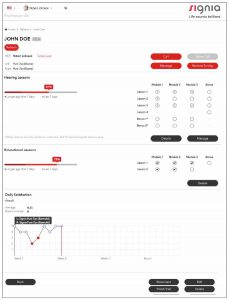 Figure 5. The patient profile view of the HCP portal displays the patient’s detailed history of the trial period. The HCP can contact the patient and remotely fine tune the hearing aids, whenever it is needed.
Figure 5. The patient profile view of the HCP portal displays the patient’s detailed history of the trial period. The HCP can contact the patient and remotely fine tune the hearing aids, whenever it is needed.
Next to the hearing training progress bar, the HCP can check which tasks have been performed in which week, and with how much success. Besides the default hearing task schedule, the HCP can also customize hearing training programs for patients by selecting from dozens of different lessons about noise perception, communication and environmental sounds.
As mentioned before, if a neutral or negative rating has been given by the patient for either the hearing trainings or for the daily satisfaction, the portal page shows the HCP the reason the patient gave for the low rating. This can serve as a trigger for the HCP to contact the patient to discuss the problem and find a solution.
As we mentioned earlier, one of the key advantages of TeleCare is that it allows HCPs to send new hearing aid settings remotely to the patient’s hearing aids. For example, if the patient gives a negative rating on the daily satisfaction and selected that the reason for this rating was because everything was too loud. At this point, the HCP can use the portal to initiate a conversation with the patient to find out more about the situation via text messages or audio call. The HCP decides after the conversation that the patient could try out a lower gain setting. The professional portal allows the HCP to make these adjustments directly in the portal without going into Connexx (Figure 6). He can then send these settings via the portal to the patient to try out immediately.
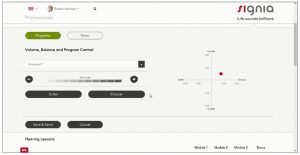 Figure 6. Remote fine-tuning user interface in the HCP portal. When necessary, the HCP can change hearing aid settings without the hassle of a fitting appointment.
Figure 6. Remote fine-tuning user interface in the HCP portal. When necessary, the HCP can change hearing aid settings without the hassle of a fitting appointment.All the remotely performed fine-tuning changes remain activated and effective until the next fitting appointment when the HCP has the opportunity to permanently approved or rejected the changes via the Connexx fitting software according to patient feedback.
TeleCare for Every Practice
TeleCare is versatile also in terms of brand coverage. It can be used together with all hearing aid brands, not only Signia. The communication channel, daily satisfaction ratings, and hearing trainings are brand-independent features which can provide significant benefit for patients who are fitted with non-Signia hearing aids. Only the remote control functions and the remote fine tuning capabilities are limited to Signia primax hearing aids. This compatibility broadens the usage and advantages offered by TeleCare and allow even more patients to benefit from a closely guided trial period.
The high quality of service, provided by the HCP through the TeleCare system, helps the HCP distinguish his professional expertise and the hearing aids offered by his practice from the less effective personal sound amplification products (PSAPs) and hearing aids obtained from other sources.
Field Study Findings
A field test to evaluate the effectiveness of TeleCare was carried out with practicing HCPs and their patients in the United States and Germany over four months. A total of 25 HCPs and 150 patients used TeleCare and reported their experiences. Preliminary results show that when using TeleCare, the average hearing aid return rate decreased by 20%; the number of follow-up fitting appointments necessary before the patient was satisfied with the fitting decreased by 35%; and the length of the trial period (from initial fit to the completion of hearing aid purchase) decreased by 25% (Figure 7).
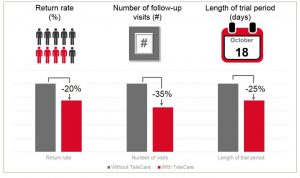 Figure 7. Field Study results show that TeleCare reduces hearing aid return rate, number of follow up visits, and the length of the trial period.
Figure 7. Field Study results show that TeleCare reduces hearing aid return rate, number of follow up visits, and the length of the trial period.These real world findings confirm that Signia TeleCare serves its intended purpose. Incorporating TeleCare into hearing care saves time for patients and HCPs, both in terms of fewer fitting appointments and shorter appointments. Yet despite less “face time,” by using TeleCare, hearing aid adoption rates increased and patients were more satisfied.
Furthermore, the patients who took part in the field tests were also asked to rate their experience. Results showed that 80% of patients describe the app as easy to use, 68% describe the use of the app as a positive experience, and 72% of the patients were motivated by the app to test and use their hearing instruments. An analysis of a sample of app users showed their average age to be 70 with the oldest app user being 88 years old.
Individual feedback from field test participants are equally encouraging as the numbers. Among the numerous positive comments, one patient reported that “I especially liked the hearing trainings. I did all of them. They were very useful for me. I wish I could reach even more trainings via the app, I would like to continue
this.” From the HCPs, one comment reads “the 10-15 minutes I spend every day checking the portal page is that I’m not losing but actually winning. The patients are better informed about the hearing aids and adapting faster. Therefore, we don’t need as many follow up fitting appointments, the appointments are shorter, and there are more patients deciding to buy hearing aids in the end.”
Summary
In our rapidly changing world, hearing aid users have changed as well. They have higher expectations about hearing care services than what they had 5 or 10 years ago. Due to the tremendous development of mobile communication nowadays, it is a fundamental user requirement to be able to reach online services and to use modern mobile applications.
Signia TeleCare is a comprehensive professional service which offers numerous benefits for both patients and professionals. It is a communication channel which connects the HCP and the patient during the trial period, and makes the trial period transparent for the HCP. It is an information channel which helps the patient better adjust to the hearing aids, and to access useful tips and tricks about his instruments. It is a service delivery channel which allows patients to receive new hearing aid settings from the HCP via the smartphone, and resolve problems in real-life situations. It is also a hearing training tool which helps patients experience, and set realistic expectations for a variety of listening situations.
TeleCare is a modern tool designed by HCPs for both HCPs and patients. It is a new service platform which brings patients and hearing care professionals closer together during the critical trial period and beyond. This closeness keeps patient satisfaction with their new hearing aids high and remove the roadblocks toward hearing aid adoption. Studies have consistently shown that professional counseling and guidance are critical for successful patient adoption, and continued satisfaction with hearing aids. TeleCare facilitates this process by making it easier than ever for patients to get the help they need, and for professionals to provide a higher standard of care even after the patient has left the HCP’s office.
References
European Hearing Instrument Manufacturers Association. (2016, May). Hearing Aids improve Hearing – and a LOT more. Trends derived from the EuroTrak databases 2009-2015. Retrieved on Oct 13, 2016 from
http://www.ehima.com/wp-content/uploads/2016/EuroTrak-trends-2009-2015-and-MT9.pdf
Hearing Aid Sales Increase by 4.8% in 2014; RICs Continue Market Domination. (2015, January 20). The Hearing Review. Hearing Review. Retrieved on Oct 13, 2016 from
http://www.hearingreview.com/2015/01/hearing-aid-sales-increase-4-8-2014-rics-continue-marketdomination/
McCormack, A, Fortnum, H. (2013). Why Do People Fitted with Hearing Aids Not Wear Them? International Journal of Audiology, 52(5), 360–368.
Melody, M. (2007). Software-based auditory training program found to reduce hearing aid return rate. The Hearing Journal, 60(8), 32-35. Retrieved on October 13, 2016 from
http://journals.lww.com/thehearingjournal/Fulltext/2007/08000/Software_based_auditory_training_program_found_to.5.aspx
Kochkin, S., Beck, D. L., Christensen, L. A., Compton-Conley, C., Fligor, B. J., Kricos, P. B., McSpaden, J. B., Mueller, H. G., Nilsson, M. J., Northern, J. L., Powers, T. A., Sweetow, R. W., Taylor, B., Turner, R. G. (2010). MarkeTrak VIII: The Impact of the Hearing Healthcare Professional on Hearing Aid User
Success. The Hearing Review 17 (4), 12-34. Retrieved on Oct 13, 2016 from
http://idainstitute.com/fileadmin/user_upload/Downloads/MarkeTrak%20VIII%20Hearing%20Review%202010.pdf
Várallyay, G., Pape, S., & Meyers, C. (2015). Automatic steering: the director of the binax soundtrack. AudiologyOnline, Article 14353. Retrieved on Oct 13, 2016 from
http://www.audiologyonline.com/articles/automatic-steering-director-binax-soundtrack-14353

